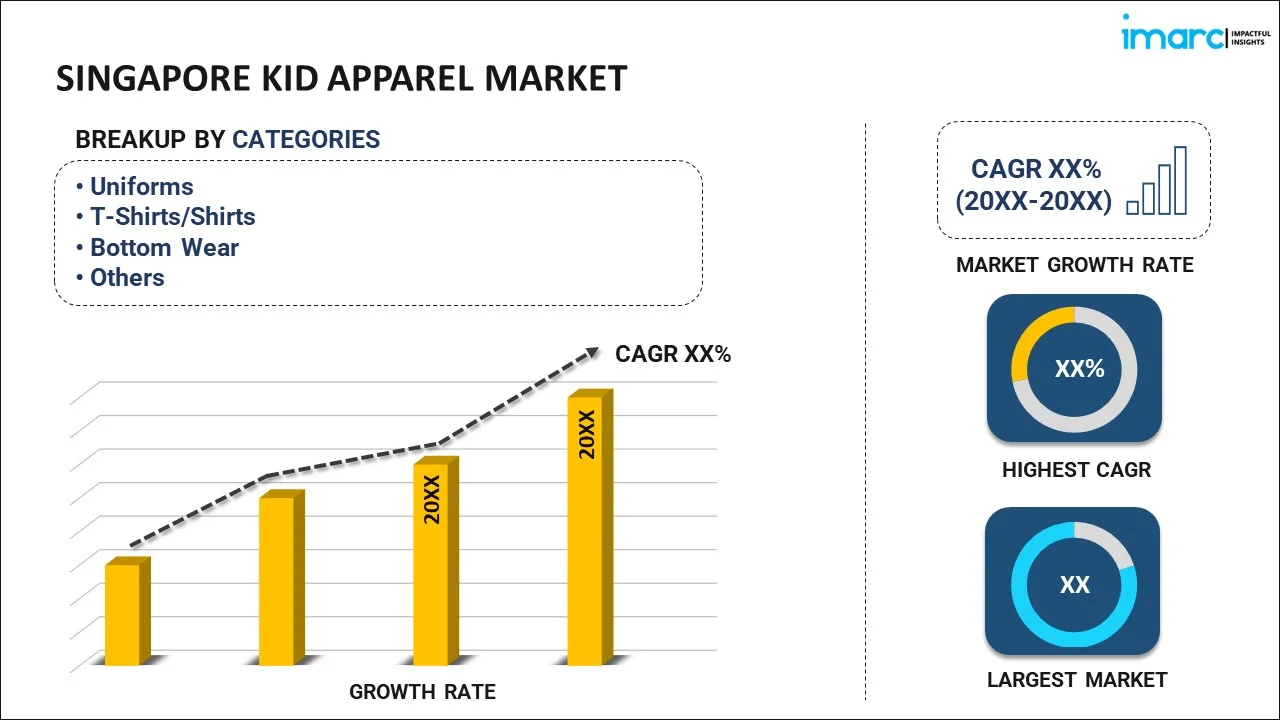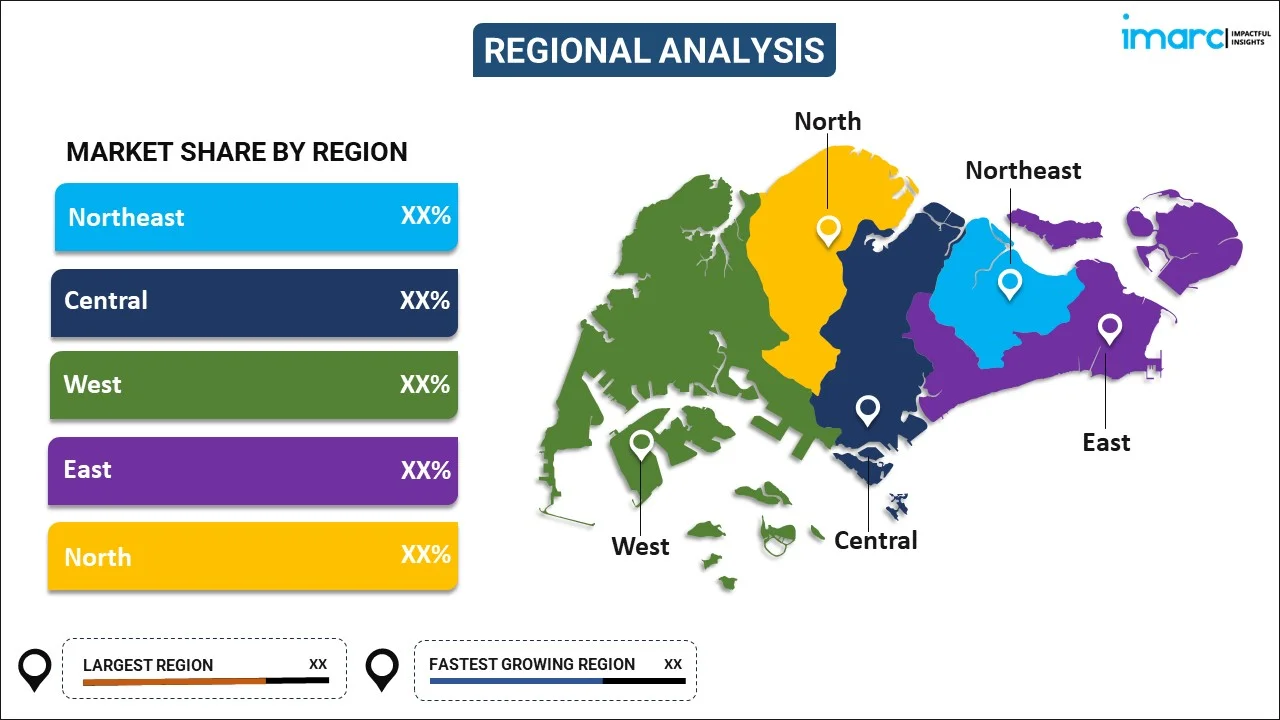
Singapore Kid Apparel Market Report by Category (Uniforms, T-shirts/Shirts, Bottom Wear, Ethnic Wear, Dresses, Denims, and Others), Season (Summer Wear, Winter Wear, All Season Wear), Distribution Channel (Supermarkets and Hypermarkets, Exclusive Stores, Multi-Brand Retail Outlets, Online, and Others), Gender (Girls, Boys), Sector (Organized, Unorganized), Cloth Material (Nylon and Rayon, Wool, Cotton Mix/Blended, Polyester, Cotton, and Others), and Region 2024-2032
Singapore Kid Apparel Market Overview:
The Singapore kid apparel market is projected to exhibit a growth rate (CAGR) of 6.10% during 2024-2032. The market is driven by the growing population, changing fashion trends, rising awareness about child comfort, expansion of e-commerce platforms, and innovations in design and technology as per evolving individual preferences.
|
Report Attribute
|
Key Statistics
|
|---|---|
|
Base Year
|
2023 |
|
Forecast Years
|
2024-2032
|
|
Historical Years
|
2018-2023
|
| Market Growth Rate (2024-2032) | 6.10% |
Singapore Kid Apparel Market Trends:
Expansion of E-Commerce Platforms
An article published in 2024 on the website of the International Trade Administration (ITA) shows that the Singaporean eCommerce market’s gross merchandise volume is expected to reach US$11 billion by 2025. E-commerce platforms provide a convenient and accessible channel for parents to purchase kid apparel from anywhere, anytime. This expanding reach allows kid apparel brands to tap into a larger customer base beyond their physical store locations, thereby driving the growth of the market. Additionally, online platforms offer a wide variety of kid apparel products from local and international brands, providing people with a diverse range of options. This diversity encourages exploration and experimentation with different styles and brands, ultimately stimulating the demand in the kid apparel market.
In line with this, the flexibility offered by online shopping is appropriate for parents who may not have the time to visit physical shops. The ability to browse and purchase kid apparel with just a few clicks enhances the overall shopping experience, leading to increased sales and market growth. Online stores and sellers use big data analysis and machine learning for the recommendation of products relevant to individual interests and browsing history. This targeted approach helps parents discover relevant kid apparel items, increasing the likelihood of purchase.
Growing Population
According to the National Population and Talent Division (NPTD) website, Singapore’s total population stood at 5.92 million as at June 2023, a 5.0 per cent increase from June 2022. A growing population means more children, which directly translates to a larger customer base for kid apparel. Children outgrow their clothes quickly, necessitating frequent purchases of new apparel. With a growing population, there is a continuous cycle of children aging into new sizes, thereby sustaining demand for kid apparel. Furthermore, a larger population often signifies greater diversity in preferences, lifestyles, and socioeconomic backgrounds. This diversity is leading to a broader range of demands for kid apparel, including varying styles, sizes, and price points, which in turn encourages market growth and product innovations to cater as per these diverse needs.
Besides this, with a larger customer base, there is an increasing competition among retailers and key players to attract people. This competition is also fostering shifts in product differentiation, promotion techniques, and placement, all of which contribute to creating a much more active and diverse market for kid apparel. The sustained growth of the total population ensures the long-term viability of the kid apparel market, providing a stable foundation for businesses operating in this sector to plan for future growth and investments.
Singapore Kid Apparel Market News:
- January 18, 2024: The Parentinc, Singapore-based startup acquired baby product retailer Motherswork to expand their offline customer base in the region.
- May 14, 2024: Gap collaborated with California clothing label DÔEN on a collection of women’s and kids’ apparel and accessories.
Singapore Kid Apparel Market Segmentation:
IMARC Group provides an analysis of the key trends in each segment of the market, along with forecasts at the country level for 2024-2032. Our report has categorized the market based on category, season, distribution channel, gender, sector and cloth material.
Category Insights:

- Uniforms
- T-shirts/Shirts
- Bottom Wear
- Ethnic Wear
- Dresses
- Denims
- Others
The report has provided a detailed breakup and analysis of the market based on the category. This includes uniforms, t-shirts/shirts, bottom wear, ethnic wear, dresses, denims, and others.
Season Insights:
- Summer Wear
- Winter Wear
- All Season Wear
A detailed breakup and analysis of the market based on the season have also been provided in the report. This includes summer wear, winter wear, and all season wear.
Distribution Channel Insights:
- Supermarkets and Hypermarkets
- Exclusive Stores
- Multi-Brand Retail Outlets
- Online
- Others
The report has provided a detailed breakup and analysis of the market based on the distribution channel. This includes supermarkets and hypermarkets, exclusive stores, multi-brand retail outlets, online, and others.
Gender Insights:
- Girls
- Boys
A detailed breakup and analysis of the market based on the gender have also been provided in the report. This includes girls and boys.
Sector Insights:
- Organized
- Unorganized
The report has provided a detailed breakup and analysis of the market based on the sector. This includes organized and unorganized.
Cloth Material Insights:
- Nylon and Rayon
- Wool
- Cotton Mix/Blended
- Polyester
- Cotton
- Others
A detailed breakup and analysis of the market based on the cloth material have also been provided in the report. This includes nylon and rayon, wool, cotton mix/blended, polyester, cotton, and others.
Regional Insights:

- North-East
- Central
- West
- East
- North
The report has also provided a comprehensive analysis of all the major regional markets, which include North-East, Central, West, East, and North.
Competitive Landscape:
The market research report has also provided a comprehensive analysis of the competitive landscape in the market. Competitive analysis such as market structure, key player positioning, top winning strategies, competitive dashboard, and company evaluation quadrant has been covered in the report. Also, detailed profiles of all major companies have been provided.
Singapore Kid Apparel Market Report Coverage:
| Report Features | Details |
|---|---|
| Base Year of the Analysis | 2023 |
| Historical Period | 2018-2023 |
| Forecast Period | 2024-2032 |
| Units | Billion US$ |
| Scope of the Report | Exploration of Historical Trends and Market Outlook, Industry Catalysts and Challenges, Segment-Wise Historical and Future Market Assessment:
|
| Categories Covered | Uniforms, T-Shirts/Shirts, Bottom Wear, Ethnic Wear, Dresses, Denims, Others |
| Seasons Covered | Summer Wear, Winter Wear, All Season Wear |
| Distribution Channels Covered | Supermarkets and Hypermarkets, Exclusive Stores, Multi-Brand Retail Outlets, Online, Others |
| Genders Covered | Girls, Boys |
| Sectors Covered | Organized, Unorganized |
| Cloth Materials Covered | Nylon and Rayon, Wool, Cotton Mix/Blended, Polyester, Cotton, Others |
| Regions Covered | North-East, Central, West, East, North |
| Customization Scope | 10% Free Customization |
| Post-Sale Analyst Support | 10-12 Weeks |
| Delivery Format | PDF and Excel through Email (We can also provide the editable version of the report in PPT/Word format on special request) |
Key Questions Answered in This Report:
- How has the Singapore kid apparel market performed so far and how will it perform in the coming years?
- What has been the impact of COVID-19 on the Singapore kid apparel market?
- What is the breakup of the Singapore kid apparel market on the basis of category?
- What is the breakup of the Singapore kid apparel market on the basis of season?
- What is the breakup of the Singapore kid apparel market on the basis of distribution channel?
- What is the breakup of the Singapore kid apparel market on the basis of gender?
- What is the breakup of the Singapore kid apparel market on the basis of sector?
- What is the breakup of the Singapore kid apparel market on the basis of cloth material?
- What are the various stages in the value chain of the Singapore kid apparel market?
- What are the key driving factors and challenges in the Singapore kid apparel?
- What is the structure of the Singapore kid apparel market and who are the key players?
- What is the degree of competition in the Singapore kid apparel market?
Key Benefits for Stakeholders:
- IMARC’s industry report offers a comprehensive quantitative analysis of various market segments, historical and current market trends, market forecasts, and dynamics of the Singapore kid apparel market from 2018-2032.
- The research report provides the latest information on the market drivers, challenges, and opportunities in the Singapore kid apparel market.
- Porter's five forces analysis assist stakeholders in assessing the impact of new entrants, competitive rivalry, supplier power, buyer power, and the threat of substitution. It helps stakeholders to analyze the level of competition within the Singapore kid apparel industry and its attractiveness.
- Competitive landscape allows stakeholders to understand their competitive environment and provides an insight into the current positions of key players in the market.
Need more help?
- Speak to our experienced analysts for insights on the current market scenarios.
- Include additional segments and countries to customize the report as per your requirement.
- Gain an unparalleled competitive advantage in your domain by understanding how to utilize the report and positively impacting your operations and revenue.
- For further assistance, please connect with our analysts.
 Inquire Before Buying
Inquire Before Buying
 Speak to an Analyst
Speak to an Analyst
 Request Brochure
Request Brochure
 Request Customization
Request Customization




.webp)




.webp)












